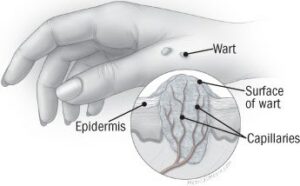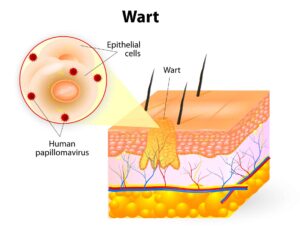Warts

Got Warts? Minimally Invasive Wart Removal Really Works.
Warts are uncomfortable, unsightly, and extremely common. Worse yet, they’re one of the most treatment-resistant conditions regularly seen by our doctor.
If you’ve got verruca, as we in the medical profession call them, then this information is old news. Read on to discover what exactly warts are. Also how and why they form. Most importantly, you’ll discover what you can do about this stubborn problem.
What Causes Warts?
On the surface of the skin, the hard protein keratin grows excessively and quickly as a result of HPV.
Warts develop as a result of this:
Different HPV strains result in various wart types
Close skin-to-skin contact and contact with objects that have recently been exposed to HPV are two ways that these strains can spread.
The following are some ways the virus can spread to other bodily parts:
- shaving the face or legs
- Sucking fingers
- Biting fingernails
- Having warts around the nail
Infection risk is increased by damp or injured skin, such as a cut or scrape.
A person who has cuts on their feet, for instance, is more prone to get a verruca by going to public swimming pools.
Harmless yet highly contagious
Fortunately, verruca are usually harmless. In many cases they’ll go away on their own without any treatment. They become much more problematic in other cases, however. Simple activities like standing and waling can become quite painful. A patient’s quality of life can be significantly degraded by this “simple” problem.
Yet today is actually a (relatively) good time to have warts. Modern wart removal procedures do exactly what they’re supposed to do with no collateral damage. Quite simply, our doctors now have options which can successfully treat warts in virtually all patients. This includes diabetics and others with more complicated autoimmune needs.
| Common types of skin warts | ||
| Type | Appearance | Characteristics |
| Common Wart | Grey to brown light colored; often has black dots; Rough raised surface. | Appear all over, most commonly a wart on the hand. Can be found under finger and toenails, making treatment difficult. |
| Plantar-Verruca Plantaris | Light greyish brown; has black/dark red dots from small blood vessels; Spongey rough irregular surface, often flattened on weight bearing areas. | Seen only on the bottom of the foot, often large clusters grow together called a mosaic wart. |
| Flat Wart | smaller, flatter, smooth pink | commonly seen on the face, shins and hands. Often grow in large numbers and are much smaller than other types. |

Warts are benign skin growths that appear when a human papillomavirus (HPV) infects the top layer of the skin.
We also offer it for the treatment of more delicate areas
Can Home Remedies Treat Warts?
Yes, since warts aren’t so dangerous it’s easy to treat them with home remedies, these remedies can be really effective if your situation is mild.
Here are some of the best home remedies for warts:
- Aloe Vera
Aloe Vera is a best remedy when it comes to skin problems because it has some qualities that improve your skin health.
It has anti-inflammatory properties which means applying it on your warts will help you get rid of them.
If there is any swelling or redness around the wart then it can help you deal with it too!
- Apple Cider Vinegar
An acidic chemical called apple cider vinegar is created from fermented apple juice. It is believed to function similarly to salicylic acid, a popular wart therapy that gradually removes the wart by peeling away contaminated skin.
Additionally, vinegar has inherent antibacterial qualities that may help combat HPV, although more research is required.
Apple cider vinegar should always be diluted with water. Chemical burns and irritation could result from the acidity. Additionally, avoid using it on exposed wounds.
Are there lifestyle changes that can help prevent the recurrence of warts?
While there’s no foolproof way to prevent the recurrence of warts, certain lifestyle changes may reduce the risk. Here are some recommendations:
- Practice Good Hand Hygiene: Regular handwashing helps minimize the risk of spreading warts to other parts of your body or to other people.
- Avoid Touching Warts: Refrain from picking at or scratching warts to prevent the virus from spreading.
- Keep Feet Dry: Warts on the feet (plantar warts) thrive in moist environments. Keep your feet clean and dry, especially in communal areas like locker rooms.
- Change Shoes and Socks Regularly: Rotate your shoes and wear moisture-wicking socks to maintain dryness and reduce the risk of plantar warts.
- Don’t Share Personal Items: Avoid sharing towels, razors, or other personal items, as the wart virus can spread through direct contact.
How does cryotherapy work in treating warts, and what are the side effects?
Cryotherapy is a common method for treating warts, and it involves freezing the wart using liquid nitrogen or another freezing agent. Here’s how it works:
- Application of Cold Temperature: Liquid nitrogen or another cryogenic substance is applied directly to the wart, causing the surrounding tissue to freeze.
- Cellular Damage: The extreme cold temperature damages the cells of the wart, leading to the formation of ice crystals within the cells.
- Thawing Process: After a brief period of freezing, the area is allowed to thaw. This freeze-thaw cycle disrupts the blood supply to the wart, leading to its death.
- Immune Response: The body’s immune system is then activated to recognize and remove the dead wart tissue.
Side Effects of Cryotherapy for Warts:
- Pain: Cryotherapy may cause some discomfort or pain during and after the procedure.
- Swelling: Swelling may occur in the treated area.
